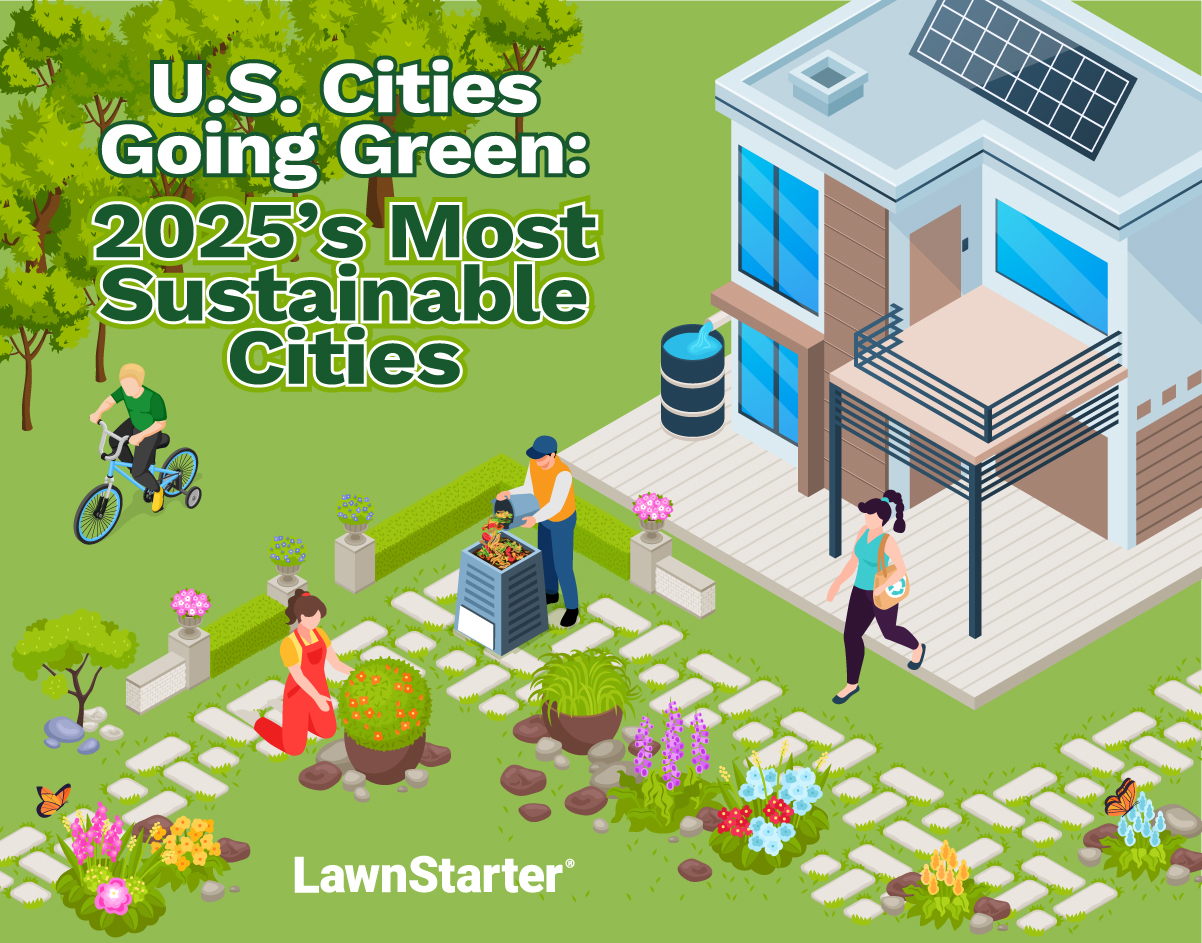
From solar panel rebates to green buildings and composting programs, which U.S. cities are leading the nation for Earth-friendly initiatives and sustainable urban development?
To mark the 2025 Net Zero Conference on Oct. 1, LawnStarter ranked 2025’s Most Sustainable Cities.
To rank the nation’s greenest cities, we compared the 500 largest U.S. cities using 47 eco-conscious metrics — such as restrictions on gas-powered lawn equipment, the share of car-free commutes, and access to zero-waste grocery stores — sorted into 5 categories.
Sustainability Stats at a Glance
See where your city scores in our ranking below. To learn how we ranked the cities, see our methodology.
Contents
- Top 5 Sustainable U.S. Cities
- Sustainable City Rankings
- Key Green Insights
- Ask the Experts
- Not So Sustainable Cities
- Methodology
- Growing a Sustainable Backyard
Top 5 Sustainable U.S. Cities
Check out the video below for highlights on each of our top 5 Most Sustainable Cities.
Top 5 Local Insights
No. 1: New York
After rolling out the citywide mandatory composting project, the New York Department of Sanitation reports collecting about 5 million pounds of compostable trash on a weekly basis.
At the beginning of 2025, NYC began its congestion pricing program, which charges drivers a toll within a dense zone of Manhattan to discourage traffic.
In 2024, NYC became the first U.S. city to include climate issues in the city budget and created a Green Economy Action Plan to bolster the city’s sustainable workforce, anticipating 400,000 green-collar jobs created by 2040.
The Staten Island Ferry is currently transitioning to be powered by renewable diesel.
No. 2: Portland, Oregon
Portland is home to the world’s largest commercial urban “living building” — the PAE Living Building, a regenerative structure designed to create its own energy, capture and recycle water, and be storm resilient.
Portland Sunday Parkways is an annual series of events where streets are closed to cars and locals are encouraged to bike, roll, and walk through different neighborhoods in the city.
No. 3: Los Angeles
Los Angeles established a Green Jobs Roadmap to meet sustainability goals ahead of the 2028 Olympics, where LA hopes to stand out as a global climate leader. One notable project is a street that can wirelessly charge electric vehicles as they drive.
Construction is underway for the Groundwater Replenishment Project, which will recycle the city’s wastewater and return an estimated 22,000 acre-feet of water per year to the San Fernando Groundwater Basin.
The city’s Green New Deal plan includes goals for LA to run on 100% renewable energy by 2045 and divert 100% of waste from landfills by 2050.
No. 4: San Francisco
San Francisco stands out as a sustainable leader, from achieving 100% renewable electricity, to developing an impressive biking infrastructure, and being the first U.S. city to implement a program for and later mandate composting.
In 2023, the city allocated $900,000 toward Climate Action Plan Community Grants for improving sustainability measures on a neighborhood level.
Recent green infrastructure initiatives include improving stormwater management through rain gardens, permeable hardscaping, and developing water reuse systems.
No. 5: Seattle
Seattle has spent over $2 million toward green job training and access, and is now home to a zero-waste arena, the Climate Pledge Arena.
Sign up for an eco-tour with the Duwamish Tribe.
Sustainable City Rankings
Out of the 500 biggest U.S. cities:
- 459 cities — 91.8% — have a local Clean City Coalition.
- 164 cities — 32.8% — have a plastic bag ban.
- 151 cities — 30.2% — have bans or restrictions on gas-powered lawn equipment.
- 140 cities — 28% — are members of Local Governments for Sustainability (ICLEI).
- 135 cities — 27% — have added electric buses to their fleets.
- 77 cities — 15.4% — have an Urban Heat Island program established.
See how each city fared in our ranking:
Key Green Insights
Connecticut and Mid-Atlantic states — Maryland, New York, and Pennsylvania — stand out with all their ranked cities scoring in the most sustainable half.
80% of the California cities ranked in our study land in the top half. The Golden State has forged paths for composting programs, the green lawn care movement, and infrastructure for electric vehicles. Pacific Coast states are prime for an EV road trip, thanks to the West Coast Electric Highway, a network of fast-charging stations every 25-50 miles.
🔌 Energy efficiency is a win-win, helping homeowners save money while reducing wasted energy. San Diego (No. 26) claims the highest number of certified zero-energy buildings, with 27. Colorado cities Lakewood (No. 119) and Denver (No. 15) have the most financial incentives supporting renewables and energy efficiency.
🪱Composting is growing in cities across the nation — with new pilot programs emerging in cities like Detroit (No. 312), Fayetteville, Arkansas (No. 124), and Alexandria, Virginia (No. 33).
Green Scenes in Mid-Sized Cities
♻️Rochester, New York (No. 7), has the most recycling facilities per 100,000 residents, followed by Albany, New York (No. 32). New York State offers 5-cent refunds for recycling cans and bottles, and like in my hometown in the Adirondacks, many of these deposit stations are conveniently located at grocery store entrances.
🚌Lancaster, California (No. 190) has the highest share of electric buses, 87%, followed by Anaheim, California (No. 118), and New York (No. 1).
🚙 Carpool scenes are strong in Iowa City, Iowa (No. 57), Daly City, California (No. 224), and New York cities Albany (No. 32) and Syracuse (No. 44), with less than 60% of commuters driving solo.
🔎 Melbourne, Florida (No. 333), has the most thrift shops per 100,000 residents and the highest Google search rate for sustainability-related terms over the past year per 100,000 residents.
Emerging Eco-Friendly Strategies and Unexpected Highlights
🏡Georgia cities Sandy Springs (No. 279), Roswell (No. 309), Johns Creek (No. 394), and Atlanta (No. 17) have the highest shares of green homes for sale — meaning homes with LEED or Energy Star certification, solar panels, or other eco-friendly features — according to Redfin. The highest concentration of sustainable home builders is around the NYC metro area, representing the top 9 cities in this metric.
🗑While San Bernardino, California (No. 240), ranks as the dirtiest city in the U.S., its neighbor, Rialto (No. 220), is home to North America’s largest organic waste-to-energy facility, Rialto Bioenergy Facility. This region of California will also soon be serviced by a zero-emission hydrogen-powered train.
🔋Georgetown, Texas (No. 406), lands in the less sustainable half of our ranking due to a lack of green transportation options and eco-friendly policies. However, this Austin suburb runs on 100% renewable energy.
💡A Boston suburb, Framingham, Massachusetts, was chosen to pilot the nation’s first utility-owned geothermal network. If proven successful, it may be replicated in towns across Massachusetts or even throughout the U.S.
🌬One of the country’s largest renewable energy projects is underway in Arizona and New Mexico. The SunZia project will harness wind energy in New Mexico, then transport the power to Arizona via a 550-mile high-voltage direct current (HVDC). Currently in the construction phase, the project is expected to begin operations in 2026.
Ask the Experts
America needs sustainable solutions that stick. We turned to a panel of experts to weigh in and share their tips on adopting a more eco-friendly lifestyle. Read their thoughts below.
- What innovative sustainability ideas will make the most impact in the next 10-20 years?
- What are your top three tips for green living?
- Why is the U.S. so far behind other countries on sustainable transportation advancements like mass transit, including high-speed trains? What would it take to catch up?
- What’s one example of grassroots or community-driven sustainability that could be replicated nationwide?
- With concerns of many companies greenwashing, what red flags should consumers look out for when evaluating whether a company’s “green” initiative is legitimate?




What innovative sustainability ideas will make the most impact in the next 10–20 years?
I think we’ll see the biggest impact from solutions that marry technology with behavior change. Things like AI-powered waste sorting, smart bins that track contamination, and apps that gamify recycling or food waste reduction could help cities and businesses cut tons of trash headed to landfills.
At the same time, regenerative design will be key. Whether it’s buildings that produce more energy than they consume or packaging made entirely from compostable, renewable materials, the real magic will come when innovation makes the sustainable choice the easiest, cheapest, and most convenient option.
What are your top three tips for green living?
1. Protect our pollinators. “Weeds” are vital to our ecosystem, as their blooms feed pollinators, such as butterflies and bees. These insects are critical to our food supplies, so mowing too early and spraying lawns with poisonous weed killer solutions, such as RoundUp, are detrimental to our pollinator populations.
2. Focus on food waste. Cutting back on wasted food saves money and slashes methane emissions from landfills. Purchase smaller quantities more times per week instead of massive bulk purchases 1-2 times per month. This will help you manage and rotate your foods responsibly before they have a chance to spoil. Compost any rotten foods if you can, or at least meal plan for the week and eat what you buy. You can always plug a couple of ingredients that you already have on hand into an AI generator, like ChatGPT, and it will develop a menu and recipe based on those very items. It will even build out a shopping list for you to identify where the recipe gaps are.
3. Buy less, buy better. Fast fashion and single-use goods eat up resources, especially water. Choose durable, repairable items—even if they cost a bit more upfront, they last longer. Check in your local community if there are “Fix-it Clinics” or “Repair Cafes” where people come together to fix broken items, such as jewelry, small electronics (think hair dryers and toasters), and zippers on clothing.
4. BONUS – Vote with your wallet and your ballot. Support businesses and policies that are serious about sustainability. Individual actions matter, but systemic change multiplies impact.
Why is the U.S. so far behind on sustainable transportation like mass transit and highspeed trains? What would it take to catch up?
Three big reasons:
- Americans’ love affair with the car.
- Our mentality of rugged individualism.
- The political gridlock around infrastructure funding.
The U.S. built its economy around cheap gas, sprawling suburbs, and highways, while countries in Europe and Asia invested early in dense cities and public transit.
To catch up, we’d need massive federal and state investment in modern rail and transit systems, along with zoning reforms that make cities more walkable and bike-friendly. It’s less about technology because we already know how to build trains; it’s more about political will and long-term planning.
What’s one example of grassroots or community-driven sustainability that could be replicated nationwide?
Community composting hubs. I’ve seen neighborhoods pool resources to set up small-scale compost drop-offs that serve apartments and homes without very much yard space. Volunteers manage the bins, local gardens or farms use the finished compost, and suddenly you’ve got a circular system that keeps food scraps local and out of the landfill. It’s simple, affordable, and builds real community connection. It also helps build our connection to how our food is grown, harvested, and how it ends up on our plates.
With concerns of greenwashing, what red flags should consumers look out for?
Watch for vague claims like “eco-friendly” or “all natural” without the details. If a company doesn’t share data, such as an annual Corporate Sustainability Report (or CSR), the percent of recycled content in their products, carbon footprint reductions, third-party certifications, etc., then that’s a red flag.
Another is when a company launches a flashy green product line but does nothing to change its overall internal operations regarding its water and energy consumption and how much waste it generates. Real sustainability shows up in data and marketing transparency, measurable progress, and willingness to admit what still needs improvement./

What innovative sustainability ideas will make the most impact in the next 10–20 years?
The great news is that many of our most impactful solutions already exist. We don’t necessarily need brand-new technologies, but rather a reimagination of how our systems work.
- Expanding public transit and building more walkable cities can drastically reduce emissions while improving the quality of life.
- Shifting away from factory farms and supporting family farmers, particularly those employing regenerative and local food practices, can help restore ecosystems and enhance food security.
- And perhaps most importantly, fostering community involvement and engagement can create the social shift we need to prioritize sustainability truly.
What are your top three tips for green living?
- Get involved locally. Volunteering with environmental or community organizations is one of the most effective ways to create a lasting impact beyond individual choices.
- Consume less by being intentional about shopping, asking yourself if you really need something before bringing it home.
- Utilize your skills, whether it’s storytelling, organizing, or a technical expertise, to contribute to the broader movement for sustainability.
Why is the U.S. so far behind other countries on sustainable transportation advancements like mass transit, including high-speed trains? What would it take to catch up?
The U.S. is largely behind because our infrastructure was built around cars, highways, and suburban sprawl, while other countries continued to invest in mass transit. Political gridlock and the scale of investment required have also slowed progress.
To catch up, we’d need federal and state-level commitments to prioritize rail and transit over highway expansion, strong funding mechanisms, and a cultural shift that views public transit not as a “last resort,” but as a modern, convenient, and climate-smart choice.
What’s one example of grassroots or community-driven sustainability that could be replicated nationwide?
Community composting programs are a powerful grassroots solution that could be scaled nationally. They not only divert food waste from landfills, reducing methane emissions, but also create rich soil that can be used for local gardens and urban farms.
These programs build awareness of waste reduction while fostering stronger connections within communities. Paired with education and local government support, they could become a cornerstone of sustainable living across the U.S.
With concerns of many companies greenwashing, what red flags should consumers look out for when evaluating whether a company’s “green” initiative is legitimate?
Consumers should be wary of vague marketing claims or packaging that merely label a product as “green” without substance.
Fake eco-labels or certifications that are not third-party verified are another warning sign. When possible, shopping locally or supporting small businesses is a great way to avoid large-scale greenwashing, while also reinvesting in your community.

What are your top three tips for green living?
My top three tips for sustainable living are:
- Use what you have. Find creative ways to repurpose items in your home and wear the clothes in your closet instead of buying new.
- Don’t let perfectionism keep you from trying. Make the eco-friendly lifestyle adjustment even if it seems intimidating. It’s okay to be an imperfect sustainability advocate.
- Just pick one area of your life if eco-conscious living feels overwhelming. If making sustainable swaps seems like a lot, start with one simple swap or pick a certain room in your home to focus on. This makes it seem more approachable.
What’s one example of grassroots or community-driven sustainability that could be replicated nationwide?
Curbside composting pickup is one thing that I think could be replicated nationwide.
I live in Seattle, and the city makes it easy for residents to participate. Our compost is picked up with our trash every week. So, all we have to do is collect our food scraps throughout the week and set them out for pick up. Unfortunately, a lot of cities don’t have this.
With concerns of many companies greenwashing, what red flags should consumers look out for when evaluating whether a company’s “green” initiative is legitimate?
I think when companies have goals that are set super far out that can be a red flag for greenwashing. A lot of large corporations will set goals for 2030 or 2050, and then when those years roll around, they often just push the goal back.
Try focusing on what the company is doing now. Evaluate what materials they’re using, where their products are made, if they are offsetting their carbon footprint, and what packaging they are using. Companies that truly care about sustainability will have initiatives with this woven into their business model early on.
Emily Waddell is the Founder of The Honest Consumer.
Not So Sustainable Cities
Cities in Kansas, Kentucky, Oklahoma, and South Dakota score in the bottom half. These 4 states don’t offer many financial incentives for renewables and energy-efficient upgrades.
The ranked cities in these states also have no bans on plastic bags nor restrictions on gas-powered lawn equipment. Only Lawrence (No. 398) and Wichita (No. 359) are members of Local Governments for Sustainability (ICLEI).
Unplugging Other Lowlights
Methodology
First, we determined the factors (metrics) that are most relevant to rank the Most Sustainable Cities. We then assigned a weight to each factor based on its importance and grouped those factors into 5 categories: Policy, Sustainable Development, Pollution, Transportation, and Food Access. The categories, factors, and their weights are listed in the table below.
For each of the 500 biggest U.S. cities, we then gathered data on each factor from the sources listed below the table.
Finally, we calculated scores (out of 100 points) for each city to determine its rank in each factor, each category, and overall. A city’s Overall Score is the average of its scores across all factors and categories. The highest Overall Score ranked “Most Sustainable” (No. 1) and the lowest “Least Sustainable” (No. 500).
Notes:
- The “Least Sustainable” among individual factors may not be No. 500 due to ties.
- Rainwater Harvesting Legality: Based on energy.gov, with scores applied as follows:
- Very Limited = 1
- Not Illegal/No Regulations = 2
- No Regulations/Encouraged = 3
- State Regulations = 4
- State Regulations/Encouraged = 5
- State Regulations/Incentives = 6
Sources:
AARP, American Council for an Energy-Efficient Economy, DSIRE, Earth911, Electricity Local, GBIG, Global Green, Google Ads, Green Restaurant Association, Houzz, Litterless, Local Governments for Sustainability, National Conference of State Legislatures, New Buildings Institute, OpenTable, Other LawnStarter Studies, the Real Yellow Pages, Redfin, ReferenceUSA, Sadie Seasongoods, Swoodson Says, Texas A&M Transportation Institute, Trust for Public Land, U.S. Census Bureau, U.S. Department of Agriculture, U.S. Department of Energy, U.S. Department of Transportation, U.S. Environmental Protection Agency, Valley Forge Fabrics Inc., Walk Score, World Water Reserve, and Yelp
Growing a Sustainable Backyard
Lawns have grown a bad rap in many sustainable spheres, but your backyard doesn’t have to be an environmental enemy.
How you grow and care for your lawn can impact local biodiversity rates, water conservation, and pollution levels. Backyard landscapes can absorb carbon dioxide, manage stormwater runoff, and prevent soil erosion.
Whether your yard is big or small, you can improve sustainability in your own landscape with help from our guides below.
- Lower your water bills with native plants and xeriscaping. You can also limit water waste by upgrading to a smart water controller and sprinkler system.
- Don’t pick up your grass clippings after mowing, let them compost — aka grasscycling.
- Optimize your lawn and landscape watering practices.
- Switch to an eco-friendly grass alternative.
- Create a bee-friendly backyard with pollinator-friendly landscaping.
- Practice organic land management: Use organic lawn fertilizer, herbicides, and pest control methods.
- Start composting your leftover food scraps.
- Opt for eco-friendly lawn care equipment:
- Go high tech with robot mowers.
- Upgrade to an electric lawn mower.
Hire a local LawnStarter crew to keep your lawn healthy or our local landscapers to xeriscape your yard.
Notes from LawnStarter’s Editor-in-Chief, Jeff Herman
What advice would you give homeowners looking to improve sustainability in their backyards?
Leaves as Mulch: Leaf removal season is here, so why send bags of leaves to a landfill when you can mulch them with your mower, adding nutrients back to your lawn? That’s sustainability at home and something you can easily do.
Garden-to-Table Fruits, Vegetables, and Herbs: I’m a big believer in garden-to-table meals. Growing tomatoes, beets, carrots, basil, and strawberries in a garden and picking fruit from trees in your backyard saves all the packaging and shipping costs. Nothing beats the taste of a homegrown peach or tomato.
When you need a tomato, just walk outside. No need to drive to the store. Food desert? Not in my backyard. Not if you grow your own.
Pollinator Gardens: Seeing butterflies and hummingbirds flitter among the flowers in our yard in Gainesville, Florida, brought me a lot of joy. It’s cheap entertainment, and you’re doing good for the pollinators, too. I miss sitting on the porch with a coffee watching nature stop by my front yard.
What tips would you share with a homeowner seeking a sustainable-minded landscaper or lawn care professional?
Ask a Landscaper: Do you install permeable driveways and sidewalks instead of concrete driveways and sidewalks? What native plants work best in my yard to draw pollinators while needing little care or maintenance on my part?
Ask a Lawn Care Professional: What do you do with the grass clippings? Do you recycle them, returning nutrients to the lawn? For lawn treatments like fertilization, do you have an organic fertilizer option?
What surprised you most about the results of this year’s ranking?
New York doesn’t seem to be a sustainable leader, but I think that’s just my preconceptions about the city coming into play. With all those skyscrapers and apartment high-rises, that leads to a lot of trash and items to recycle. It’s working, though. And now the Big Apple also is the Big Composter too.
- High-resolution images of cities
- 2022’s Most Sustainable Cities ranking results
- 2023’s Most Sustainable Cities ranking results
- 2024’s Most Sustainable Cities ranking results
Main Photo Credit: Aris Berroya
Editorial Contributors
-
Sav Maive
Author
Sav Maive is a writer based in San Antonio, with roots in the Adirondacks and Blue Ridge Mountains. She has also lived in San Diego and Washington, D.C., and has been writing lawn care stories for LawnStarter since 2021. With a passion for sustainability, Sav loves covering eco-friendly practices to empower homeowners to cultivate beautiful yards while building a healthier planet.
Learn more -

Kimberly Magerl
Editor
Kimberly Magerl is a writer and editor rooted in Illinois, with time spent living in Hawaii and Texas. She has covered lawn care and landscaping for LawnStarter since 2022, bringing an environmental lens to every project. A longtime plant lover, she’s especially passionate about ocean conservation and sustainability.
Learn more